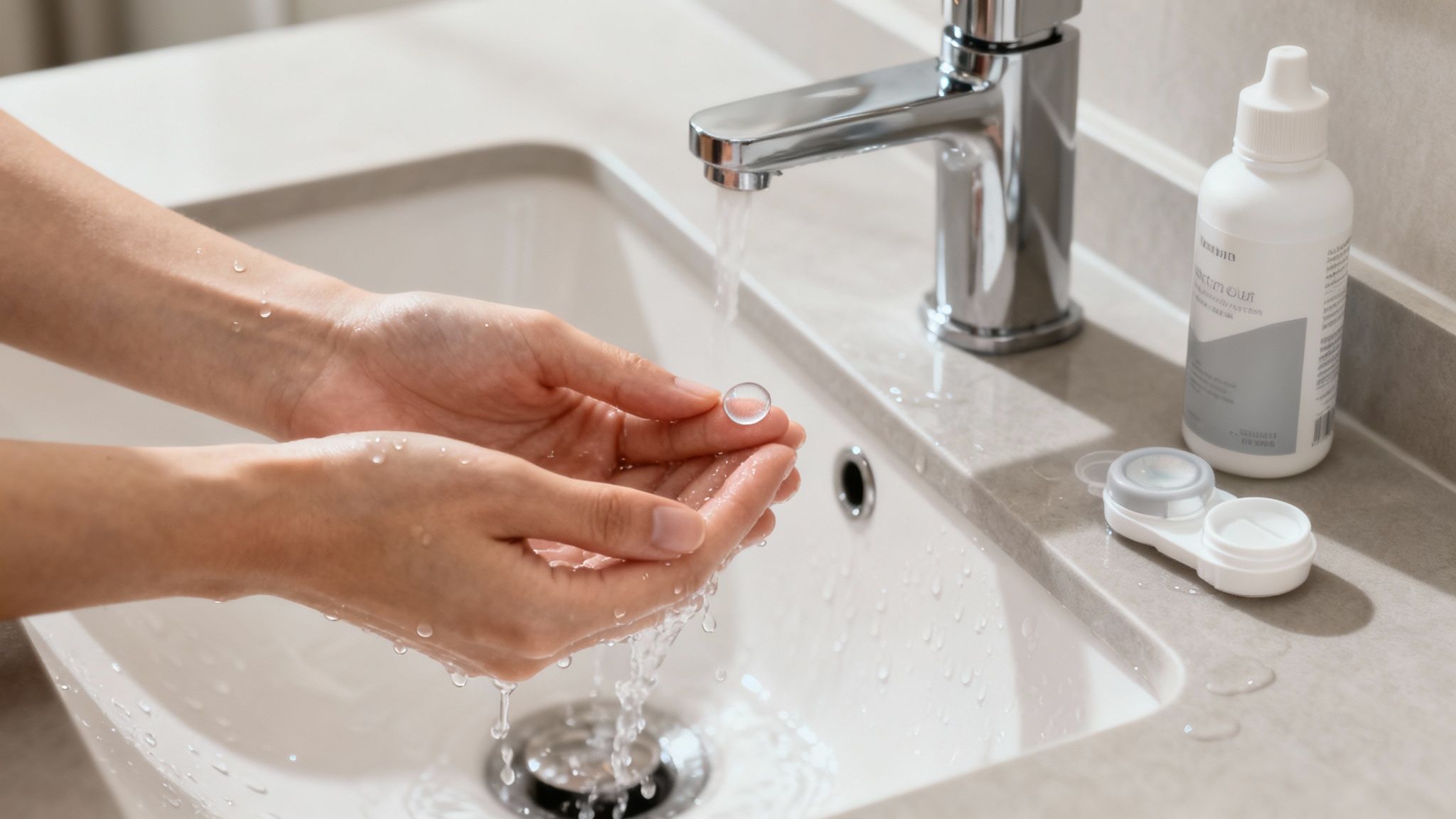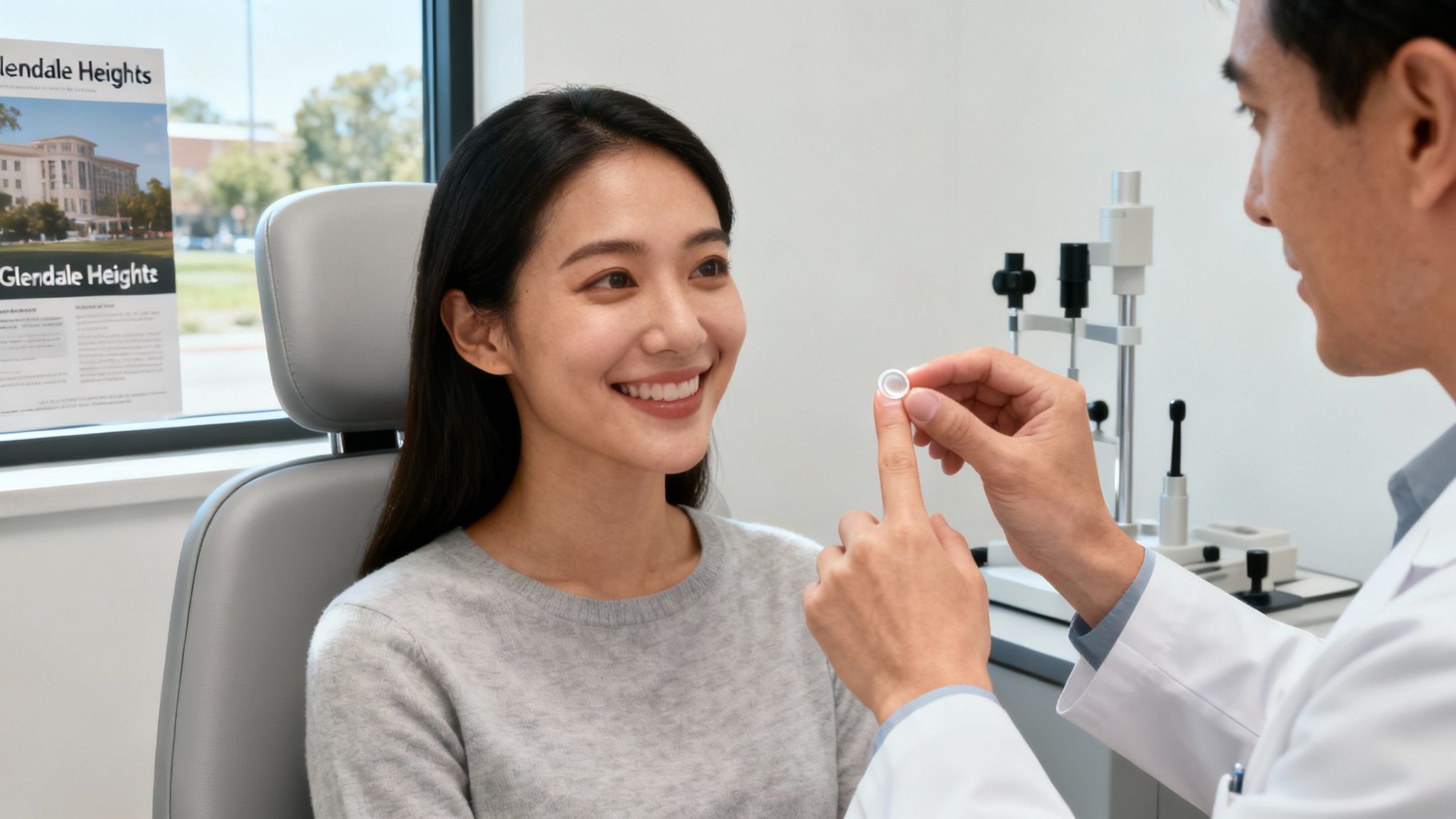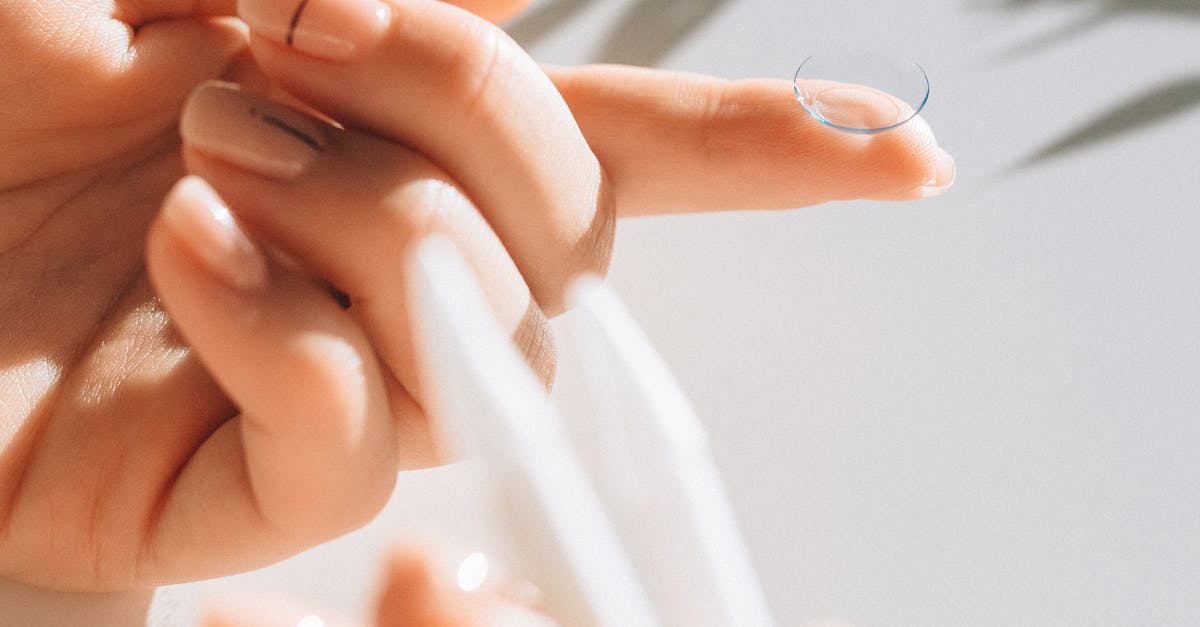Thinking about making the jump from glasses to contact lenses? It's a common crossroads for many of our patients here in Glendale Heights, from students at Glenbard West High School to professionals commuting down North Avenue. At its core, the choice boils down to this: contacts give you incredible visual freedom, but they come with the responsibility of daily care and a slightly higher risk of eye infections if you're not careful.
For many, that trade-off is absolutely worth it. At iDoctor, our goal is to help you find the perfect vision solution for your lifestyle right here in our Glendale Heights boutique.
Weighing the Pros and Cons of Contact Lenses
So, are contact lenses the right move for you? There’s no single right answer—it really depends on your lifestyle, what you value in vision correction, and how much daily maintenance you're comfortable with.
The biggest win for contacts is the crystal-clear, panoramic vision they provide. Think about it: no frames blocking your peripheral view, no annoying glare, and no fogging up when you come inside on a cold day. Whether you're playing a round at Glendale Lakes Golf Club or just enjoying a walk through East Branch Forest Preserve, contacts move with your eyes for a completely natural field of vision.
A Quick Comparison
On the flip side, you can't beat eyeglasses for sheer convenience. They’re easy to pop on and off, require very little cleaning, and carry virtually no risk of causing an eye infection. Plus, they can be a bold fashion statement, and at iDoctor, we offer a curated selection from luxury brands like Cartier and Gucci to affordable styles from Ray-Ban and Coach.
To lay it all out, this infographic gives you a great visual breakdown of the key differences.
As you can see, it’s a classic case of freedom versus simplicity. Contacts offer an unparalleled visual experience but demand a consistent care routine. Glasses are simple and safe but can sometimes feel limiting.
To help you compare these options side-by-side, here’s a quick table that summarizes the main points.
Contact Lenses vs Eyeglasses At a Glance
| Feature | Contact Lenses (Pros & Cons) | Eyeglasses (Pros & Cons) |
|---|---|---|
| Vision Quality | Pro: Unobstructed, natural peripheral vision. No frames in your line of sight. | Con: Frames can limit peripheral vision. Can be affected by glare and reflections. |
| Active Lifestyle | Pro: Excellent for sports and physical activities. They don't fall off or get in the way. | Con: Can be cumbersome, slip down, or get damaged during sports. |
| Weather | Pro: Unaffected by rain or fog, making them great for all weather conditions. | Con: Lenses can fog up in changing temperatures and get spotted with rain. |
| Convenience | Con: Require daily cleaning, removal, and proper storage. Running out of lenses can be an issue. | Pro: Easy to put on and take off. Minimal maintenance required. |
| Eye Health | Con: Higher risk of eye infections if not handled hygienically. Can cause dry eye for some wearers. | Pro: Lower risk of infection. Can offer some protection from dust and debris. |
| Appearance | Pro: No change to your natural appearance. Great for people who don't like how they look in glasses. | Pro: Can be a stylish fashion accessory to complement your look. |
Ultimately, what works best really depends on what you prioritize for your vision and daily life.
And remember, it doesn't have to be an all-or-nothing decision! A lot of people enjoy the best of both worlds. They wear contacts for work, sports, or social events and then switch to glasses to relax at home in the evening.
If you're curious to learn more about the different types of lenses available, our guide comparing daily disposable vs. monthly contact lenses in Glendale Heights is a great next step. It gets into the nitty-gritty to help you figure out which option truly fits your routine.
The Benefits of Seeing the World Through Your Own Eyes
For so many of our patients, the number one reason they switch to contact lenses is the feeling of total visual freedom. It’s about getting a clear, wide-open view of the world that glasses, with their frames and boundaries, just can’t match.
Think about playing with your kids at Camera Park or going for a run along the Great Western Trail. With contacts, there are no glasses slipping down your nose, bouncing around, or fogging up. It’s just you and the moment.
A More Natural, Uninterrupted View
One of the biggest functional upgrades is the improvement in your peripheral vision. Because a contact lens sits right on your eye and moves with it, your entire field of view stays sharp and in focus.
You won’t have frames creating blind spots or distracting lines at the edge of your vision. This makes for a much more immersive experience, whether you're navigating traffic on North Avenue or just kicking back to watch a movie.
For anyone with an active lifestyle, this is a huge deal. The stability and expansive view you get with contacts can be a real advantage for performance and safety in sports and other physical activities.
Contacts also aren't bothered by the weather. They won’t fog up when you come inside from the cold or get covered in raindrops during a downpour, which means you get consistently clear sight, no matter what's happening outside.
Looks and Everyday Convenience
Beyond the practical perks, many people simply prefer how they look without glasses. Contacts don't change your appearance, cover up your features, or need to be matched with your outfit for the day. Plus, you can wear any style of non-prescription sunglasses you want, from designer frames to sporty wraparounds.
This combination of convenience and aesthetics is a big reason why the contact lens market is booming. Valued at about USD 14.18 billion in 2024, it’s expected to grow to USD 22.10 billion by 2032. A major factor is that refractive errors affect nearly 30% of people worldwide.
This freedom also shows up in small but significant ways every day. You can lie on your side to read a book or watch TV without a glasses frame awkwardly digging into the side of your head.
At the end of the day, people love contacts for a reason. If you're thinking about making the switch, the next step is to understand what types are out there. To get you started, take a look at our detailed guide on prescription contact lenses, which explains the options we offer right here in Glendale Heights.
Understanding the Risks and Responsibilities
The freedom that comes with contact lenses is incredible, but it's important to go in with your eyes wide open—pun intended. For every advantage, there's a trade-off, and with contacts, that trade-off is responsibility. Contacts aren't like glasses you can just pop on and forget. They're medical devices that sit directly on your eyes, and they demand a consistent daily care routine.
This isn't just a matter of convenience; it’s a matter of health. The biggest risk with contact lenses is the potential for eye infections. A condition called microbial keratitis, which is an infection of the cornea, sounds scary—and it can be—but it's almost always preventable with good habits. Think of it like brushing your teeth. It’s a non-negotiable daily habit that protects your long-term health.
This commitment to hygiene is truly what separates a happy, successful contact lens wearer from someone who runs into problems. Cutting corners on cleaning, storing, or replacing your lenses on schedule is an open invitation for harmful bacteria to make a home in your eyes.
The Commitment to Daily Care
Being a responsible contact lens wearer is about building a routine you can stick to every single day, no exceptions. It’s more than just knowing how to put them in and take them out.
Here’s a snapshot of what that daily commitment looks like:
- Washing Hands Thoroughly: Always start by washing and drying your hands before you touch your lenses. This simple step keeps germs from your hands out of your eyes.
- Proper Cleaning: Every time you take your lenses out (unless you use daily disposables), you have to clean and disinfect them with the solution your eye doctor recommended. No shortcuts.
- Correct Storage: Your lenses need to be stored in a clean case filled with fresh solution. Never, ever top off old solution or use tap water.
- Following the Schedule: Sticking to your replacement schedule—whether it's daily, bi-weekly, or monthly—is crucial. It prevents the buildup of deposits and keeps your risk of infection low.
A cardinal rule of contact lens wear is to never sleep in your contacts unless your doctor has specifically prescribed lenses approved for overnight wear. Sleeping in standard lenses dramatically increases your risk of a serious eye infection because it starves your cornea of oxygen.
For a more detailed guide on keeping your eyes healthy, check out our expert tips on how to prevent common contact lens infections in Glendale Heights.
The Financial Aspect
Another piece of the puzzle is the ongoing cost. A single pair of glasses might last you for years, but contact lenses are a recurring purchase. This financial commitment covers more than just the lenses themselves.
You’ll need to budget for a few things:
- A continuous supply of lenses.
- Contact lens solution for cleaning and storing them.
- Lens cases, which should be replaced every three months to avoid bacterial buildup.
- A backup pair of glasses for those times when you can't or don't want to wear your contacts.
While the convenience is priceless for many people, it's smart to be realistic about these recurring expenses. Understanding these responsibilities—both for your eye health and your wallet—is the key to making a great decision and enjoying clear, comfortable vision with your contacts for years to come.
Could Contact Lenses Work For You?
Figuring out if contact lenses are the right choice for you goes beyond a simple pros and cons list. It’s really about seeing if they fit your specific eyes and your day-to-day life. While not everyone is a perfect match, modern lens technology has come so far that more people can wear them comfortably than ever before. The only way to know for sure is to get an expert evaluation from an eye doctor in Glendale Heights.
So, what makes someone a good candidate? It comes down to a few key things: your prescription, the overall health of your eyes, and even your daily habits. If you have a relatively straightforward prescription and your eyes are in good shape, you're probably in a great spot to start.
Still, some conditions can make wearing contacts a bit trickier.
Factors That Influence Candidacy
Your eye doctor will take a close look at a few specific areas to see if contacts are a viable option. It's all about identifying any underlying issues that could lead to discomfort or potential complications down the road.
Here’s what we typically consider:
- Chronic Dry Eye: If your eyes naturally struggle to produce enough tears, contacts can sometimes make that feeling of dryness and irritation worse.
- Severe Allergies: Pollen and other allergens love to stick to the surface of contact lenses, which can leave your eyes feeling itchy, red, and watery.
- Work Environment: Do you work around a lot of dust, debris, or chemical fumes? In those cases, glasses might be a safer bet to shield your eyes.
- Prescription Complexity: Most prescriptions are easily handled by contacts. However, very high or complex prescriptions might need specialized lenses to get the job done right.
Even if one of these sounds like you, don't count yourself out just yet. The lens materials and designs available today offer incredible solutions that simply didn't exist a few years ago.
The single biggest factor for success? Your own commitment. Happy, healthy contact lens wear really hinges on your willingness to stick to a daily cleaning and care routine. It's a small habit, but it's absolutely essential for protecting your vision.
Modern Solutions for More Patients
The best news is that contact lens technology has opened the door for so many people who used to think they weren't candidates. We now have fantastic options for common vision problems that once made getting a good fit difficult.
For example, toric lenses are specially engineered to correct astigmatism, giving you that crisp, stable vision you're looking for. In the same way, multifocal contact lenses act a lot like progressive glasses, providing clear sight at near, far, and in-between distances for people with presbyopia.
Ultimately, a professional evaluation is the only way to know what will work for you. A detailed eye exam in Glendale Heights here at iDoctor will give you the clear answers you need. We’ll carefully assess your eyes, talk about your lifestyle, and work with you to find the most comfortable and effective solution for your vision.
Finding the Right Type of Contact Lens
Once you’ve sized up the pros and cons of contacts, the next step is diving into the amazing variety of lenses out there. This isn't a one-size-fits-all world anymore. Modern contacts are designed to match your specific eyes, your lifestyle, and your vision needs. Knowing your options is the key to having a great conversation with your eye doctor.
The first major choice you'll make is between soft lenses and rigid gas permeable (RGP) lenses.
Soft lenses are, by a long shot, the most popular choice. Made from flexible plastics that hold water, they're famous for their out-of-the-box comfort and are super easy to get used to. On the other hand, RGP lenses are made from a firmer, more durable plastic. They can take a little getting used to, but the payoff is exceptionally crisp, clear vision. For some prescriptions and eye conditions, they’re the absolute best solution.
Soft Contact Lenses: The Go-To Choice
For most people, soft contact lenses are the clear winner. Their comfort and simplicity make them a fantastic choice, especially if you're new to contacts.
The numbers back this up. The soft contact lens market hit a staggering USD 8.91 billion in 2024, and about 75% of new wearers opt for them. The fastest-growing type? Daily disposables, thanks to how hygienic and convenient they are. But a word of caution is essential: improper use, like sleeping in lenses that aren't approved for it, can spike your risk of a serious eye infection by up to 15 times.
Within the soft lens family, you have a few different replacement schedules:
- Daily Disposables: A fresh pair every single day. You just toss them at night. It's the ultimate in hygiene—no cleaning solutions, no cases, no fuss.
- Bi-Weekly Lenses: You wear these for two weeks before swapping them for a fresh pair. They need to be cleaned and stored properly every night.
- Monthly Lenses: Worn for a full month, these are often the most budget-friendly option but require a rock-solid daily cleaning routine.
If you want to get into the nitty-gritty of which schedule fits your life best, take a look at our detailed guide on disposable contact lenses.
Specialty Lenses for Unique Vision Needs
But what if your vision isn't so straightforward? Not too long ago, conditions like astigmatism or the need for reading glasses could put contacts out of reach. Thankfully, today’s specialty lenses have completely changed the game.
Think of specialty lenses as custom-tailored suits for your eyes. Instead of a standard "off-the-rack" fit, they're designed with unique features to correct more complex vision problems. This has opened up the world of contacts to more people than ever before.
Here’s a quick look at the two most common types:
- Toric Lenses for Astigmatism: Astigmatism happens when the front of your eye is shaped more like a football than a perfect sphere, which blurs your vision at any distance. Toric lenses are cleverly designed with different powers in different parts of the lens to counteract this unique shape, giving you stable, sharp vision.
- Multifocal Lenses for Presbyopia: This is the age-related change that makes reading menus or your phone a real struggle. Multifocal contacts are like progressive eyeglass lenses—they have different zones for near, intermediate, and distance vision built right in. You can see clearly at all ranges without ever reaching for reading glasses.
Ultimately, picking the right lens comes down to your prescription, the health of your eyes, and how you plan to wear them. The only way to know for sure what's perfect for you is to get a professional fitting with an eye doctor in Glendale Heights.
Ready for Clear Vision? Here’s What to Do Next in Glendale Heights
So, you've weighed the pros and cons and are curious if contacts are for you. Great! The first step is a professional evaluation, and it's simpler than you might think. This isn't your average eye exam; it’s a dedicated contact lens fitting, which is absolutely essential for making sure your lenses are comfortable, effective, and safe for your eyes.
Think of it this way: a contact lens is a medical device that sits directly on the surface of your eye. That’s why we have to measure the unique curvature and size of your cornea to find a lens that fits just right—not too tight, and not too loose.
Why a Professional Fitting Matters So Much
Here at iDoctor, our detailed eye exams in Glendale Heights are about more than just finding your prescription. We take the time to map the surface of your eye, which helps us pick the perfect lens material, diameter, and design for your individual needs. This personalized approach is what prevents the irritation and potential damage that can come from a bad fit.
The good news is that with modern technology, over 90% of people who need vision correction can successfully wear contacts. But a professional fitting is non-negotiable. A 2023 study found that nearly 30% of people who bought contacts online never got a proper fitting, putting their eye health on the line. You can learn more about this market data and why it’s a big deal for consumer safety.
A contact lens fitting isn’t just about clear vision. It's about ensuring enough oxygen reaches your cornea to keep your eyes healthy for the long haul. It's the foundation for a lifetime of safe and comfortable wear.
Whether you're coming in from Carol Stream or you're a neighbor near Glendale Lakes Golf Club, our team is ready to help. We'll find the right contacts for you, and we can even show you our beautiful collection of designer eyeglasses in Glendale Heights for those times you want to give your eyes a rest.
Your path to clear, comfortable vision starts with a conversation. Schedule a consultation with the best optometrist in Glendale Heights today and let us help you experience a new kind of visual freedom.
Frequently Asked Questions about Contact Lenses in Glendale Heights
If you're new to contacts, you probably have a lot of questions. That’s a good thing! As eye care professionals in Glendale Heights, we’ve heard just about all of them. Here are a few of the most common ones we answer every day.
Do you carry contact lenses at your Glendale Heights location?
Yes, we do! iDoctor offers a wide selection of contact lenses in Glendale Heights, including daily disposables, bi-weekly, and monthly options from top brands. We also provide specialty lenses for conditions like astigmatism and presbyopia. Our team will help you find the perfect fit during your comprehensive contact lens exam.
Do I really need a separate contact lens fitting?
Yes, 100%. Think of it this way: a contact lens isn't just a lens, it's a medical device that sits directly on the delicate surface of your eye. A fitting is how we measure the unique curve of your cornea to ensure the lens sits perfectly. An improper fit can lead to everything from irritation and blurry vision to serious corneal damage. It's a totally different process from a glasses exam, and it's absolutely crucial for your health and comfort.
Can't I Just Use My Glasses Prescription to Order Contacts?
That’s a common misconception, but the answer is a firm no. Your glasses sit about 12 millimeters away from your eyes, while contacts rest right on them. That distance changes everything. The power, the curvature, and other measurements on a glasses prescription are simply not interchangeable with a contact lens prescription. You need a dedicated contact lens exam to get the right fit and the right vision correction.
Will My Vision Insurance Help Pay for Contacts?
It’s very likely! Most major vision insurance plans offer some form of coverage or an allowance specifically for contact lenses, and we’re proud to accept all major plans at iDoctor. How much is covered really depends on your specific plan. Our team in Glendale Heights is great at helping you navigate your benefits to make sure you get the most out of your coverage. Just ask us!
Ready to see what life is like without frames? The expert team at iDoctor is here to guide you to the perfect contact lenses for your unique eyes and lifestyle. Schedule your personalized contact lens fitting in Glendale Heights today!







